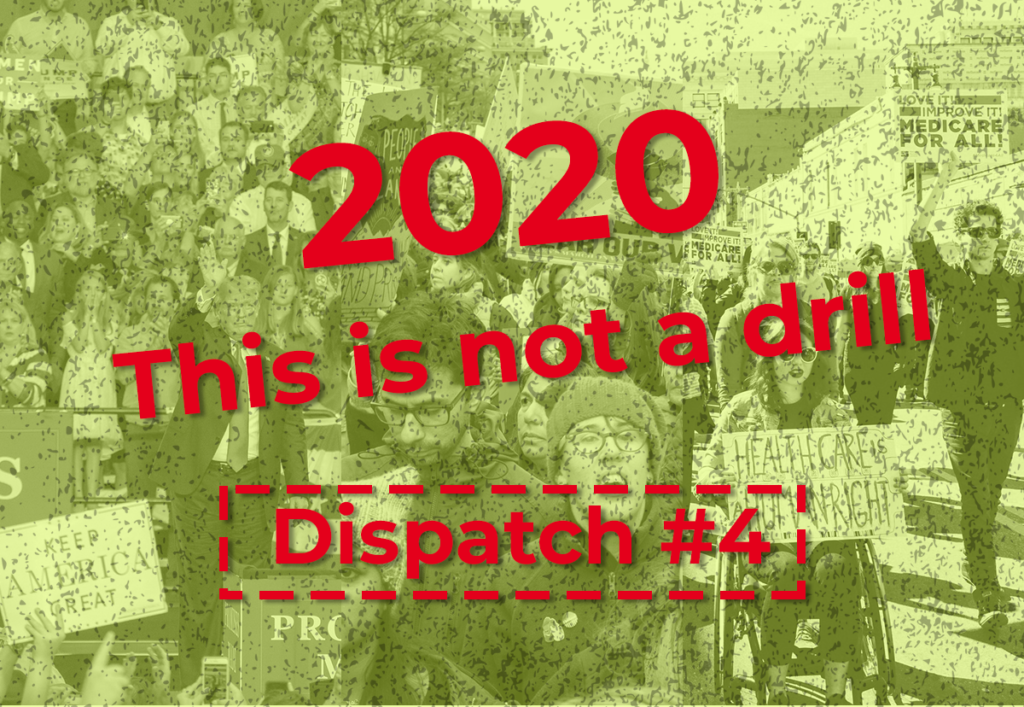One headline after another:
“Bloomberg Campaign Is a Waterfall of Cash” (New York Times, February 13)
“Bloomberg’s Billionaire Bounce: Who Needs New Hampshire When You Can Buy Your Way into Third Place?” (Politico, February 11)
“Billionaire Bloomberg Is Trying to Buy the Presidency” (Baltimore Sun, February 11)
Is this a presidential contest or a pilot of a new Hollywood sub-genre: the fallen-then-redeemed male billionaire white savior movie?
Either way, the “fallen” part is real:
- Racism: As Mayor of New York City for eight years Michael Bloomberg defended his “stop and frisk” policies this way: “Ninety-five percent of your murders – murderers and murder victims – fit one M.O. You can just take the description, Xerox it and pass it out to all the cops. They are male minorities, 16 to 25.”
- Misogyny: In 1997, Bloomberg was sued by a former employee who alleged among other things that he consistently made remarks like ‘I’d fuck that in a second’ upon seeing certain women.
- Warmongering: Bloomberg supported the Iraq War, praised Bush’s War on Terror, opposed the Iran Nuclear Agreement and during the 2014 bombardment of Gaza, in which more than 500 Palestinian kids were killed, Bloomberg told CBS News that Israel “cannot have a proportional response” when fighting Hamas.
- Hailing the 1%: Bloomberg has been a stalwart defender of Wall Street, going so far as to claim that was Congress and “not the banks that created the mortgage crisis.”
A smart guy, Bloomberg has decided that bragging about this record is not the way to build his campaign. Better to just spread his money around. He has opened 125 campaign offices around the country and hired several thousand people all being paid more – some twice as much – as staffers in other campaigns. He has already spent more than $130 million on advertising. And – if the word chutzpah didn’t already exist they’d have to invent it for this – this “stop and frisk” champion just made the biggest ad buy in the 80-year history of the Black Press (National Newspaper Publishers Association), spending $3.5 million.
The arc of democratic party neoliberalism
It’s a spectacle to behold. Some have been dazzled or bought by it. But prospects are good for the pushback to pull down its money-gilded curtain. The reason goes beyond Bloomberg individually: it’s a different moment in the Democratic Party’s relationship to neoliberalism than it was when this Wall Street archetype launched his political career.
In the wake of Ronald Reagan’s two terms and his successful handoff of the presidency to his Vice President (Bush I), what was then called “Reaganomics” was attaining dominance throughout the U.S. elite. It was an ambitious Bill Clinton who decided his road to power lay in leading the shift of the Democratic Party from its previous (if ever-slackening) support for New Deal Keynesianism into the privatize/cut social programs/reinforce racism/build-up-military-power camp.
To convince the citadels of Wall Street that he would be reliable guardian of their interests, Clinton had to overcome one big hurdle. He had to distance himself from the Democrats’ left wing, then anchored in the Black community and still retaining some strength from the 1980s Jesse Jackson campaigns and the Rainbow Coalition. Clinton demeaned an African American woman hip-hop artist and activist to send the signal that he would be “tough on a section of his own party” when needed to ram through the Democrats’ new posture. It worked, and there was a direct line from this orchestrated “Sistah Souljah Moment” to Clinton’s 1996 declaration that “the era of big government is over” which sealed the Democratic establishment’s allegiance to the neoliberal model.
It’s now 2020 and we are in a completely different moment in the Democratic Party’s relationship with neoliberalism. It still hangs on, but it has lost initiative and coherence even among the party elite, which is a key reason there is not just one dominant “centrist” candidate but rather many scrambling contenders. Rebellion against neoliberal economics among the party’s voting base is at storm-crest surge level. Communities of color are a much higher proportion of the Democratic and potentially Democratic electorate than in 1992, and the polarization with Trumpism’s naked bigotry has pushed racial justice issues to the forefront of national debate. Active backing for antiwar campaigns is nowhere near where it needs to be, but passive public opinion – and not just in “blue America” – has turned sour on the benefits of invasions and occupations.
To win the Democratic nomination on this vastly changed terrain, Bloomberg can’t target a 2020 stand-in for Sistah Souljah; rather, he has to distance himself from everything he has stood for in his entire political and business career. He’s certainly trying. He not only has apologized for his stance on” stop and frisk” but – the word chutzpah again comes to mind – has issued a “plan to rein in Wall Street“!
Will spending a few hundred million buy public acceptance of a complete makeover of a man who is the very embodiment of the hawkish neoliberal racism millions are rebelling against?
Maybe. But Bloomberg faces intense pushback from the Sanders and Warren campaigns and grassroots social movements. He “whiffed” in his first debate. Even voices out of the “establishment” express opposition. The American Prospect carried a stinging indictment of Bloomberg by its executive editor David Dayen. And Adam Jentleson, former deputy chief of staff to retired Nevada Senator Harry Reid, wrote in a New York Times Op-Ed:
“If the Democratic Party gave the nomination to a billionaire who supported Mr. Bush, it might as well shoot a big chunk of the Democratic electorate into space and hand Mr. Trump his re-election.”
On GOP side, the spectacle prevails

The other side of the great divide in today’s U.S. politics has its white billionaire savior film running too. But in Trump World, the lead character doesn’t face the kind of fierce pushback that forces him to apologize for bigotry or anything else. Rather, Trump revels in the adulation of his entire flock, all blasphemers having been exiled or silenced. Indeed, central leaders in his Evangelical base argue that he was anointed for leadership by God and as the accompanying campaign sign indicates some followers put him even higher in their heavenly pantheon. If D. W. Griffith was still alive, he’d be having an easy time filming “Make America Great Again” as a sequel to “Birth of a Nation” since he wouldn’t have to make a single change in the treatment of race, gender and violence.
But the spectacle in this quarter is more than a media show. The last few weeks alone show how it is an essential ingredient in Trump’s drive toward authoritarianism, intensified racism and war.
Take the Dancing-with-the-Stars performance put on by Trump and Attorney General William Barr. Barr is putting on a show of reprimanding his boss. But Trump cheerleader and close friend of Barr, Laura Ingraham reassured the faithful that it was all a sham, saying that “Barr was basically telling Trump, ‘Don’t worry, I got this.’” The President’s egomania may be so great he cannot abide even an orchestrated and transparently phony rebuke. But whatever distractions are provided by this soap opera, the reality on the ground is that Barr and Trump are reorganizing federal law enforcement to be an arm of GOP strongman rule.
Consider also the latest Conspiracy Theory advanced by Trump ally Senator Tom Cotton – that the Coronavirus was developed in a Chinese Communist Party laboratory. National Security Adviser Robert O’Brien seemed to make a laughingstock of himself by retreating from reality to say “We just don’t know” when pressed on the issue by a reporter. But this comes just a few weeks after Secretary of State Mike Pompeo declared the Chinese Communist Party “the central threat of our times” and the administration proposed a sharply increased military budget largely justified by that Cold War-style claim. In that context, this Conspiracy Theory is not a laughing matter. It’s racist fear-mongering charting a path toward war.
The success achieved by Trumpism’s spectacle strategy is carefully documented in McKay Coppins’ detailed study in the current issue of The Atlantic, “The Billion Dollar Disinformation Campaign to Re-Elect the President.” No one should underestimate either the resources or the determination the operational headquarters of Trump’s campaign (aptly nicknamed “The Death Star”) will devote to convincing millions to “believe everything and nothing, think that everything was possible and that nothing was true.”
“Unanswerable lies” and the “outlawing of history”
Today’s Trumpist spectacles are not identical to, but they are descended from, Joseph Goebbels “big lie” techniques in the 1930s and ’40s. The 1950s/60s stage of this evolution from one to the other was captured by Guy Debord’s now-classic work, The Society of the Spectacle, published in 1967. Debord wrote that:
“The whole life of those societies in which modern conditions of production prevail presents itself as an immense accumulation of spectacles. All that once was directly lived has become mere representation… [full of] unanswerable lies, when “truth has almost everywhere ceased to exist or, at best, has been reduced to pure hypothesis… [and we experience] the outlawing of history, when knowledge of the past has been submerged under the ceaseless circulation of information.”
Debord added that the sun never sets “on the empire of modern passivity.”
On that last point Debord was proven at least temporarily wrong, as the global upsurge of the late 1960s shook imperial power from Paris to Washington and beyond. Important gains were made in those years, but step-by-money-driven-step, the powers-that-be regained the initiative.
In the next ten months we will see whether spectacle-induced passivity or a new surge of radical activism will dominate the next political cycle in what is still, to use the imagery of Debord’s time, the belly of the beast.

